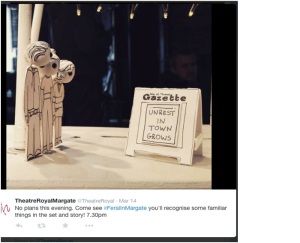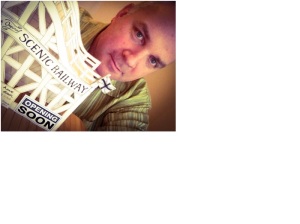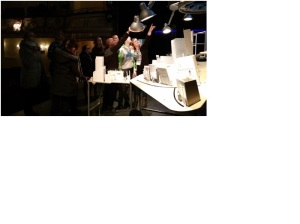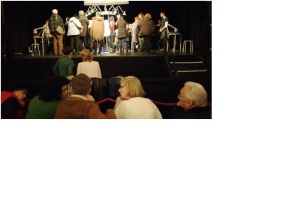by Maddy Costa
It’s been a good couple of weeks for reflections on how more people might be encouraged to come to the theatre. Playwright David Eldridge revived his blog with a rumbustious argument for “a vigorous new theatre which can reach out to a wide audience”. He confesses to a growing anxiety that: “new theatre is becoming too inward-looking, focused disproportionately on formal experiment and innovation, and collapsing the boundaries between traditional theatre and play-making, and live art.” He believes most people are put off by that kind of work; most people “want to go the theatre when they think they’re going to have ‘a good night out’.” And, he states, theatre-makers can best give them that by: “making an audience laugh and cry and catching them in a drama, and telling story and exploring ideas through dramatic action”.
A few days later, Matt Trueman wrote a column for What’s On Stage, reflecting on David’s blog alongside a couple of surveys of audience numbers and demographics. While agreeing with David to a point, Matt argues: “Accessibility is more than a matter of plain comprehensibility.” Attention needs to be paid to the culture beyond the show itself: as Matt puts it, people come not only because they anticipate a good night out, but when they “have the resources and the desire to get out to see these shows”. It matters not only what the work itself is like but where it’s programmed, how much it costs, how people hear about it, and what residues remain.
These are all questions Fuel are addressing through New Theatre in Your Neighbourhood. In developing the local engagement specialist model they’ve been looking at how word-of-mouth and personal invitations encourage more people in to the theatre, employing people who live and work in each community to make contact with local groups who might feel a particular sense of connection to a show. They’ve been looking at how touring work might be tailored to reflect a specific community, giving additional R&D time to Tortoise in a Nutshell to remake their show Feral for Margate and Poole. With Phenomenal People, staged in a gallery space in Colchester, and The Red Chair, programmed into a community hall in Malvern, Fuel are beginning to look at how they might attract audiences by staging their work outside of theatre buildings (which they do as a matter of course in Preston, programming their work into a pub, the New Continental). And, through the Theatre Clubs that I host for them, they’ve been looking at how post-show conversations might give audiences a chance to digest what they’ve seen in a fun, informal, social way that encourages them to come back and see more.
These shifts in Fuel’s relationship with audiences are vital because a lot of the work they produce is experimental, innovative and collapses the boundaries between theatre and live art – that is, precisely the stuff that David represents as elitist and off-putting. But NTiYN refuses to see this work as inaccessible to a wider audience. It says it doesn’t matter if you’re a schoolchild or a retired schoolteacher, if you earn £5,000 a year or £50,000: whatever your background, this work could be for you. It says that this work, like more traditional theatre, has the capacity to make you laugh and cry and think, it just does so in different ways. Above all, it concerns itself not with a generalised “wider audience” but a series of communities, each one made up of individuals, each one with their own resources and desires.
Working on NTiYN has encouraged me to look past the big picture to a panoply of small ones. When Matt talks about theatre shows as “social interventions that should leave a mark”, I think about Kathryn Beaumont working with groups of women in the Stockton area: women who didn’t make it along to Phenomenal People so won’t show up in its audience figures, but had a heartful time together thanks to its existence. I think about the conversation I had with two teenagers at Phenomenal People in Colchester, explaining the UK political system to them. Two years after this happened, I still think about the two teenage lads in Poole who were given free tickets to see a show by Inua Ellams, and afterwards sought him out to shake his hand, they’d loved it so much. For both of them, it was the first time they’d set foot in a theatre. It matters to me that it might have been their last, but at the same time, it doesn’t matter at all.
Theatre-maker Hannah Nicklin had similar stories in mind when responding to Matt’s piece through a series of tweets. She reflected on her own work in “community-based storytelling participative theatre” – work she doesn’t even call “theatre” when talking about it with prospective or actual participants, because: “it’s an unuseful word”. This work doesn’t show up in the kind of audience surveys that Matt made reference to, because it’s usually free or “pay what you decide”, and its profile is even lower because it doesn’t get reviewed: as Hannah puts it, “I wouldn’t invite a critic to it as that’s not who it’s for”. (I always feel a bit sad when “critics” are considered a separate species of human.) This work happens off the radar – yet it’s vital to the UK theatre scene, being the very definition of a social intervention that leaves a positive mark.
In Hannah’s work, and in the touring model NTiYN is developing, theatre isn’t a product but a cultural interaction: an invitation to step out of the ordinary, to reflect on previous experience and encounter or imagine something new. And the thing Matt doesn’t really address in his column is the extent to which, at this moment in time in the UK, under this government, the value of such cultural interactions is being systematically eroded – and, along with it, the possibility that more people might have the resources or the desire to go to the theatre. At this moment in time in the UK, under this government, theatre isn’t seen as essential to education, to social debate, to a definition of citizenship, to the health of the human brain. It’s superfluous, unless it can be quantified and measured according to market values. This is what makes me anxious every time there’s talk of “wider audiences”, every time percentages are used in reference to people. I feel like the economic argument, and the terms of that debate, are winning.



